
The following article was published in The Courier-Journal on 19 May 1885. It is presented in images below, and is transcribed following the images. Note that, while the article is interesting, the writer was obviously not writing a serious history, and was not well acquainted with the area he was describing.
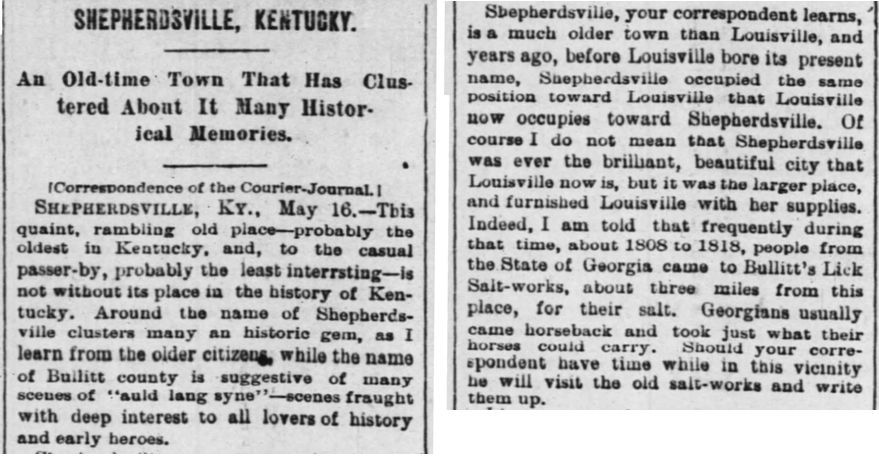
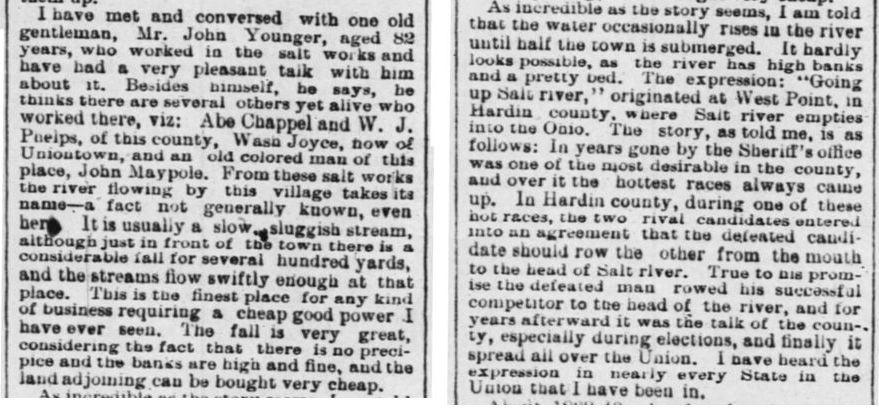
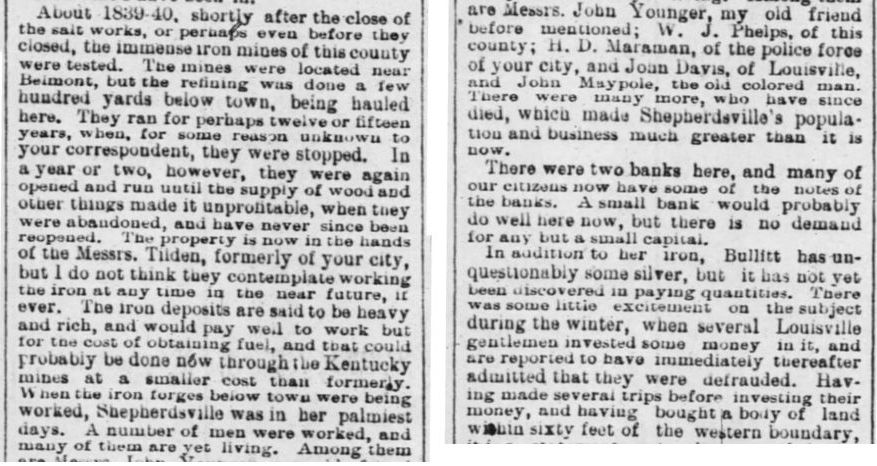
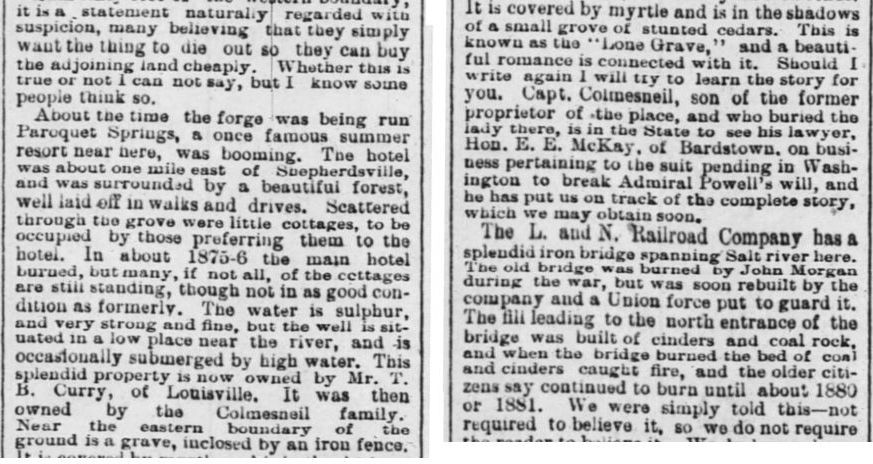
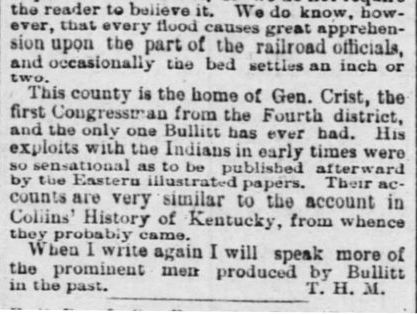
SHEPHERDSVILLE, KENTUCKY.
An Old-Time Town That Has Clustered About It Many Historical Memories
[Correspondence of the Courier-Journal.]
SHEPHERDSVILLE, Ky., May 16. - This quaint, rambling old place - probably the oldest in Kentucky, and, to the casual passer-by, probably the least interesting - is not without its place in the history of Kentucky. Around the name of Shepherdsville clusters many an historic gem, as I learn from the older citizens, while the name of Bullitt County is suggestive of many scenes of "auld lang syne" - scenes fraught with deep interest to all lovers of history and early heroes.
Shepherdsville, your correspondent learns, is a much older town than Louisville, and years ago, before Louisville bore its present name, Shepherdsville occupied the same position toward Louisville now occupies toward Shepherdsville. Of course I do not mean that Shepherdsville was ever that brilliant, beautiful city that Louisville now is, but it was the larger place, and furnished Louisville with her supplies. Indeed I am told that frequently during that time, about 1808 to 1818, people from the State of Georgia came to Bullitt's Lick Salt-works about three miles from this places, for their salt. Georgians usually came horseback and took just what their horses could carry. Should your correspondent have time while in this vicinity he will visit the old salt-works and write them up.
I have met and conversed with one old gentleman, Mr. John Younger, aged 82 years, who worked in the salt works and have and a very pleasant talk with him about it. Besides himself, he says, he thinks there are several others yet alive who worked there, viz: Abe Chappel and W. J. Phelps, of this county, Wash Joyce, now of Uniontown, and an old colored man of this place, John Maypole. From these salt works the river flowing by this village takes its name - a fact not generally known, even here. It is usually a slow, sluggish stream, although just in front of the town there is a considerable fall for several hundred yards, and the streams flow swiftly enough at that place. This is the finest place for any kind of business requiring a cheap good power I have ever seen. The fall is very great, considering the fact that there is no precipice and the banks are high and fine, and the land adjoining can be bought very cheap.
As incredible as the story seems, I am told that the water occasionally rises in the river until half the town is submerged. It hardly looks possible as the river has high banks and a pretty bed. The expression: "Going up Salt River," originated at West Point, in Hardin County, where Salt River empties into the Ohio. The story, as told me, is as follows: In years gone by the Sheriff's office was one of the most desirable in the county, and over it the hottest races always came up. In Hardin county, during one of these hot races, the two rival candidates entered into an agreement that the defeated candidate should row the other from the mouth to the head of Salt River. True to his promise the defeated man rowed his successful competitor to the head of the river, and for years afterward it was the talk of the county, especially during elections, and finally it spread all over the Union. I have heard the expression in nearly every state in the Union I have been in.
About 1839-40, shortly after the close of the salt works, or perhaps even before they closed, the immense iron mines of this county were tested. The mines were located near Belmont, but the refining was done a few hundred yards below town, being hauled here. They ran for perhaps twelve or fifteen years, when, for some reason unknown to your correspondent, they were stopped. In a year or two, however, they were again opened and run until the supply of wood and other things made it unprofitable, when they were abandoned, and have never since been reopened. The property is now in the hands of the Messrs. Tilden, formerly of your city, but I do not think they contemplate working the iron at any time in the near future, if ever. The iron deposits are said to be heavy and rich, and would pay well to work but for the cost of obtaining fuel, and that could probably be done now through the Kentucky mines at a smaller cost than formerly. When the iron forges below town were being worked, Shepherdsville was in her palmiest days. A number of men were worked, and many of them are yet living. Among them are Messrs. John Younger, my old friend before mentioned; W. J. Phelps of this county; H. D. Maraman of the police force of your city, and John Davis of Louisville, and John Maypole, the old colored man. There were many more, who have since died, which made Shepherdsville's population and business much greater than it is now.
There were two banks here, and many of our citizens now have some of the notes of the banks. A small bank would probably do well here now, but there is no demand for any but a small capital.
In addition to her iron, Bullitt has unquestionably some silver, but it has not yet been discovered in paying quantities. There was some little excitement on the subject during the winter, when several Louisville gentlemen invested some money in it, and are reported to have immediately thereafter admitted that they were defrauded. Having made several trips before investing their money, and having bought a body of land within sixty feet of the western boundary, it is a statement naturally regarded with suspicion, many believing that they simply want the thing to die out so they can buy the adjoining land cheaply. Whether this is true or not I can not say, but I know some people think so.
About the time the forge was being run Paroquet Springs, a once famous summer resort near here, was booming. The hotel was about one mile east of Shepherdsville, and was surrounded by a beautiful forest, well laid off in walks and drives. Scattered through the grove were little cottages, to be occupied by those preferring them to the hotel. In about 1875-76 the main hotel burned, but many, if not all, of the cottages are still standing, though not in as good condition as formerly. The water is sulphur, and very strong and fine, but the well is situated in a low place near the river, and is occasionally submerged by high water. This splendid property is now owned by Mr. T. B. Curry, of Louisville. It was then owned by the Colmesneil family. Near the eastern boundary of the ground is a grave, inclosed by an iron fence. It is covered by myrtle and is in the shadows of a small grove of stunted cedars. This is known as the "Lone Grave," and a beautiful romance is connected with it. Should I write again I will try to learn the story for you. Capt. Colmesneil, son of the former proprietor of the place, and who buried the lady there, is in the State to see his lawyer, Hon. E. E. McKay, of Bardstown, on business pertaining to the suit pending in Washington to break Admiral Powell's will, and he has put us on track of the complete story, which we may obtain soon.
The L. and N> Railroad Company has a splendid iron bridge spanning Salt River here. The old bridge was burned by John Morgan during the war, but was soon rebuilt by the company and a Union force put to guard it. The fill leading to the north entrance of the bridge was built of cinders and coal rock, and when the bridge burned the bed of coal and cinders caught fire, and the older citizens say continued to burn until about 1880 or 1881. We were simply told this - not required to believe it, so we do not require the reader to believe it. We do know, however, that every flood causes great apprehension upon the part of the railroad officials, and occasionally the bed settles an inch or two.
This county is the home of Gen. Crist, the first Congressman from the Fourth district, and the only one Bullitt has ever had. His exploits with the Indians in early times were so sensational as to be published afterward by the Eastern illustrated papers. Their accounts are very similar to the account in Collins' History of Kentucky, from whence they probably came.
When I write again I will speak more of the prominent men produced in the past. T.H.M.
If you, the reader, have an interest in any particular part of our county history, and wish to contribute to this effort, use the form on our Contact Us page to send us your comments about this, or any Bullitt County History page. We welcome your comments and suggestions. If you feel that we have misspoken at any point, please feel free to point this out to us.
The Bullitt County History Museum, a service of the Bullitt County Genealogical Society, is located in the county courthouse at 300 South Buckman Street (Highway 61) in Shepherdsville, Kentucky. The museum, along with its research room, is open 10 a.m. to 4 p.m. Monday through Friday. Saturday appointments are available by calling 502-921-0161 during our regular weekday hours. Admission is free. The museum, as part of the Bullitt County Genealogical Society, is a 501(c)3 tax exempt organization and is classified as a 509(a)2 public charity. Contributions and bequests are deductible under section 2055, 2106, or 2522 of the Internal Revenue Code. Page last modified: 12 Sep 2024 . Page URL: bullittcountyhistory.org/bchistory/cj_19may1885.html